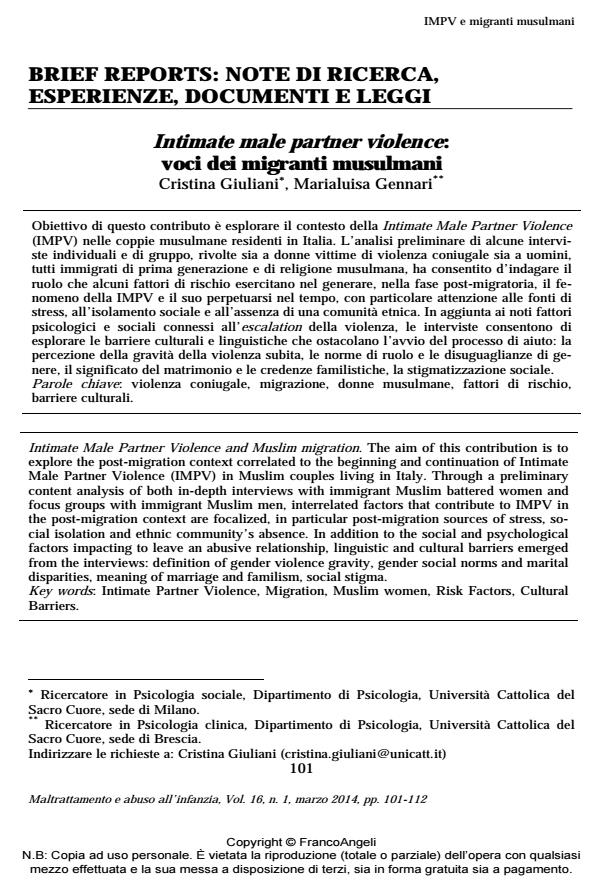Intimate Male Partner Violence and Muslim migration
Journal title MALTRATTAMENTO E ABUSO ALL’INFANZIA
Author/s Cristina Giuliani, Marialuisa Gennari
Publishing Year 2014 Issue 2014/1
Language Italian Pages 12 P. 101-112 File size 74 KB
DOI 10.3280/MAL2014-001006
DOI is like a bar code for intellectual property: to have more infomation
click here
Below, you can see the article first page
If you want to buy this article in PDF format, you can do it, following the instructions to buy download credits

FrancoAngeli is member of Publishers International Linking Association, Inc (PILA), a not-for-profit association which run the CrossRef service enabling links to and from online scholarly content.
The aim of this contribution is to explore the post-migration context correlated to the beginning and continuation of Intimate Male Partner Violence (IMPV) in Muslim couples living in Italy. Through a preliminary content analysis of both in-depth interviews with immigrant Muslim battered women and focus groups with immigrant Muslim men, interrelated factors that contribute to IMPV in the post-migration context are focalized, in particular post-migration sources of stress, social isolation and ethnic community’s absence. In addition to the social and psychological factors impacting to leave an abusive relationship, linguistic and cultural barriers emerged from the interviews: definition of gender violence gravity, gender social norms and marital disparities, meaning of marriage and familism, social stigma.
Keywords: Intimate Partner Violence, Migration, Muslim women, Risk Factors, Cultural Barriers.
- Stile genitoriale autoritario, giustificazione della violenza e messa in atto di comportamenti di Dating Aggression Maria Giulia Olivari, Gaia Cuccì, Emanuela Confalonieri, in MALTRATTAMENTO E ABUSO ALL'INFANZIA 3/2017 pp.13
DOI: 10.3280/MAL2017-003002 - Teen dating violence e fattori post-migratori: una disamina della letteratura psicosociale Cristina Giuliani, in MALTRATTAMENTO E ABUSO ALL'INFANZIA 3/2017 pp.31
DOI: 10.3280/MAL2017-003003 - Muslim immigrant men's and women's attitudes towards intimate partner violence Marialuisa Gennari, Cristina Giuliani, Monica Accordini, in Europe’s Journal of Psychology /2017 pp.688
DOI: 10.5964/ejop.v13i4.1411
Cristina Giuliani, Marialuisa Gennari, Intimate male partner violence: voci dei migranti musulmani in "MALTRATTAMENTO E ABUSO ALL’INFANZIA" 1/2014, pp 101-112, DOI: 10.3280/MAL2014-001006